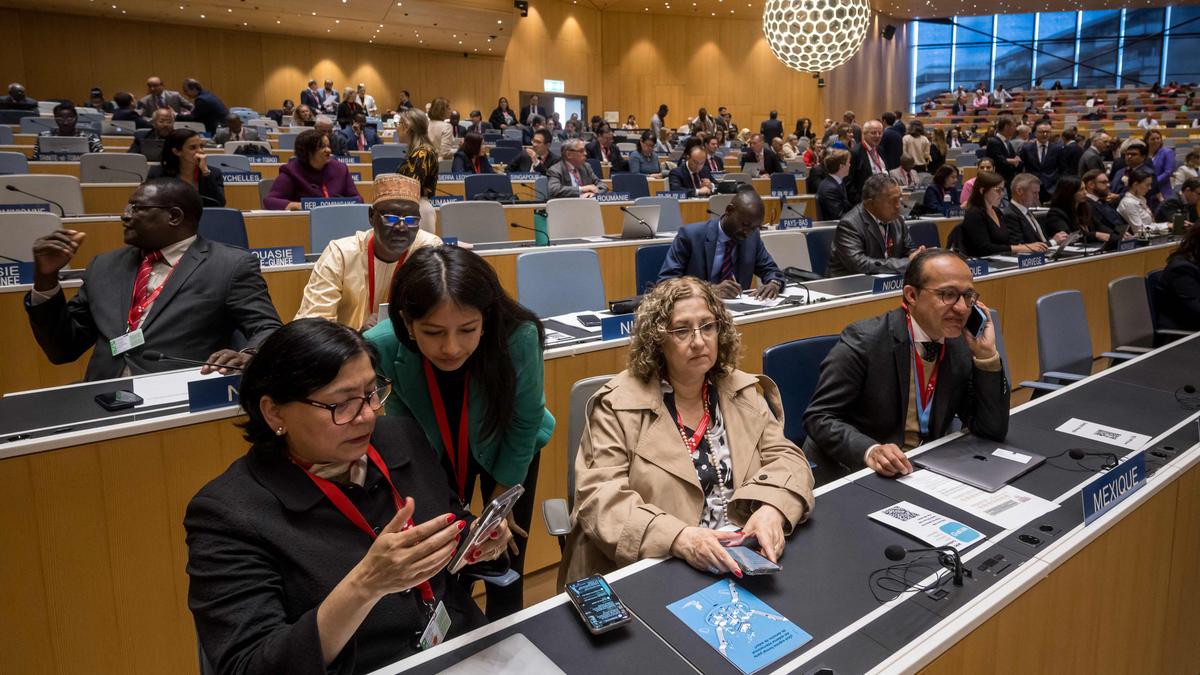- Courses
- GS Full Course 1 Year
- GS Full Course 2 Year
- GS Full Course 3 Year
- GS Full Course Till Selection
- Online Program
- GS Recorded Course
- NCERT (Recorded 500+ Hours)
- Polity Recorded Course
- Geography Recorded Course
- Economy Recorded Course
- AMAC Recorded Course
- Modern India, Post Independence & World History
- Environment Recoded Course
- Governance Recoded Course
- Science & Tech. Recoded Course
- International Relations and Internal Security Recorded Course
- Disaster Management Module Course
- Ethics Recoded Course
- Essay Recoded Course
- Current Affairs Recoded Course
- CSAT
- 5 LAYERED ARJUNA Mentorship
- Public Administration Optional
- ABOUT US
- OUR TOPPERS
- TEST SERIES
- FREE STUDY MATERIAL
- VIDEOS
- CONTACT US
WIPO Treaty on Intellectual Property, Genetic Resources, and Associated Traditional Knowledge (2024)
WIPO Treaty on Intellectual Property, Genetic Resources, and Associated Traditional Knowledge (2024)

Background & Historical Context
- The treaty was adopted in May 2024 at a WIPO Diplomatic Conference in Geneva.
- This marks the first-ever international legal agreement that requires disclosure of genetic resources and traditional knowledge (TK) used in patent applications.
- Result of 25 years of negotiations in WIPO’s IGC-GRTKF — a committee dealing with IP, genetic resources, traditional knowledge, and folklore.
- The need arose because existing IP laws (like TRIPS) mainly protect innovations from the Western context, but fail to protect collective, orally transmitted, and community-held knowledge in countries of the Global South.

Why Was This Treaty Needed?
- Problem with the Current IP System
- The TRIPS Agreement (WTO) doesn't recognize traditional knowledge because it often doesn’t meet patent criteria like:
-
- Novelty
- Inventive step
- Industrial applicability
-
- As a result, companies often patent inventions based on traditional knowledge without acknowledging or compensating Indigenous communities — this is called biopiracy.
- Efforts by Global South
- Countries like India, Brazil, and African nations have long demanded:
- Mandatory disclosure in patents of the source of genetic material or knowledge.
- Equity in benefit-sharing with Indigenous and Local Communities (ILCs).
- The CBD (Convention on Biological Diversity) and its Nagoya Protocol (2010) tried to establish the idea of access and benefit-sharing (ABS) — but they lack enforcement strength like TRIPS.
Key provisions of the treaty
1. Disclosure Requirement – Article 3
- Patent applicants must disclose the origin of genetic resources used in their invention.
- If known → Country of origin
- If not known → Source (e.g., community, database)
- If the invention uses traditional knowledge, the applicant must mention:
- The ILC that provided it or the source of TK.
But there's a big catch:
- Patent offices are not required to verify the accuracy of this disclosure (Article 3.5).
- No automatic cancellation of patent if disclosure isn’t made — unless fraudulent intent is proven (Article 5.3 & 5.4).
- This reduces the enforceability and accountability of the rule.
Information Systems – Article 6
- Countries can create databases of traditional knowledge and genetic resources.
- Must be developed in consultation with Indigenous communities.
- Should be accessible to patent offices to help prevent wrongful patenting.
- India's Traditional Knowledge Digital Library (TKDL) is highlighted as a global model.
- It helped revoke patents on turmeric and neem in the US and Europe.
- Treaty encourages other countries to build similar databases.
Major Limitations & Criticisms
1. No Definition of Traditional Knowledge
- The treaty does not define TK — left to individual countries.
- This leads to ambiguity, inconsistent interpretations, and weak protection.
- India had pushed for a clear and universal definition.
2. Narrow Definition of Source
- Treaty says the “source” can be scientific papers, public databases, patent applications — but most traditional knowledge in the Global South is oral, undocumented.
- These are not included — leaving much of oral heritage unprotected.
3. Applies Only to Patents
- Other types of IP like trademarks, copyrights, plant variety protection are not covered.
- This limits the treaty’s scope and impact.
4. No Alignment with Other Treaties
- Treaty does not clearly define how it relates to:
- TRIPS
- CBD
- Nagoya Protocol
- Though Article 7 vaguely says it should be implemented “in a mutually supportive manner,” there is no legal mechanism to ensure that.
|
UNDRIP and Traditional Knowledge: A "Soft Law" Instrument |
|
What is UNDRIP?
What Does It Say About Traditional Knowledge? 1. UNDRIP gives positive rights to Indigenous Peoples and Local Communities (ILCs) to: a. Maintain their traditional knowledge. b. Control access to it. c. Protect it from misuse or misappropriation. d. Develop it according to their customs and priorities. 2. It recognizes their ownership over their own knowledge systems — an important shift from earlier passive recognition to active empowerment. But What’s the Limitation?
UNDRIP is symbolically powerful and norm-setting for Indigenous rights, but lacks legal enforceability. While it recognizes TK rights in principle, it does not compel states to protect or enforce them, unlike binding treaties. |
India’s Position & Concerns
- India already has:
- Strong disclosure norms in its Patent Act.
- A working Access and Benefit-Sharing (ABS) system.
- TKDL, a digital database of over 2 lakh formulations from Ayurveda, Siddha, and Unani.
- However, India may now find its domestic strictness at odds with the lax international standards in this treaty.
- For instance, in India, non-disclosure of TK or biological origin is grounds for patent cancellation.
- But the treaty allows patents to remain unless fraudulent intent is shown.
- But the treaty allows patents to remain unless fraudulent intent is shown.
Is This a Victory or a Compromise?
- Positive Aspects:
- First-ever binding global treaty linking TK and genetic resources to the patent system.
- Recognizes the role and rights of Indigenous communities.
- Opens the door for future reviews and improvements (Review clause under Article 8).
- But it's a diluted version of what the Global South demanded.
- Many demands of countries like India and African nations were not accepted.
- Treaty was shaped as a “best possible compromise” rather than a true victory.
The Way Ahead
- Scope for Future Improvements
- Treaty includes a review clause — countries can push for:
- Expanding beyond patents.
- Strengthening disclosure norms.
- Adding definitions and stronger enforcement mechanisms.
- Call for Cognitive Justice
-
- Equal respect for multiple knowledge systems — Western science and traditional knowledge.
- TK should not be treated as “lesser” knowledge.
- There must be a paradigm shift in global IP frameworks to treat oral, community knowledge with the same seriousness as formal innovation.
The WIPO Treaty marks a symbolic milestone for the Global South, but its practical gains are limited. Without stricter definitions, enforcement, and broader scope, it may not adequately protect the very communities it aims to empower. The fight for equity in intellectual property regimes continues.
Comparison of International Instruments on Traditional Knowledge and Genetic Resources
|
Aspect |
UNDRIP (2007) |
TRIPS Agreement (1994) |
CBD + Nagoya Protocol (1992/2010) |
WIPO Treaty (2024) |
|
Type of Instrument |
Soft Law (Non-binding UN Declaration) |
Hard Law (Binding WTO agreement) |
Hard Law (Binding UN treaties) |
Hard Law (Binding treaty under WIPO) |
|
Main Focus |
Rights of Indigenous Peoples (broad human rights, incl. TK) |
Protection of IPRs (especially patents, copyrights, etc.) |
Conservation, sustainable use, and benefit-sharing (ABS) of biodiversity |
Patent law reform related to GR and TK |
|
Binding Nature |
Non-binding on states |
Legally binding with dispute settlement |
Legally binding, but limited enforcement |
Legally binding but with weak enforcement provisions |
|
Protection of Traditional Knowledge (TK) |
Recognizes Indigenous Peoples’ rights to maintain, control, protect, and develop their TK |
Does not recognize TK as intellectual property |
Acknowledges TK as important and requires prior informed consent (PIC) for access |
Mandates disclosure of TK used in patents, but no definition of TK provided |
|
Enforcement Mechanism |
None – relies on moral/political pressure |
Strong WTO dispute settlement; trade sanctions possible |
Limited – no strong sanctions; depends on national implementation |
No mandatory penalties; no revocation of patents unless fraud proven |
|
Recognition of Indigenous Rights |
Very strong – centers on ILC ownership and sovereignty |
No mention |
Recognizes ILCs as stewards of biodiversity and TK; requires their consent and benefit-sharing |
Mentions ILCs as knowledge holders, but no rights framework included |
|
Disclosure Requirement |
Not applicable |
No requirement to disclose source of TK or GR |
Encourages disclosure and compliance with ABS laws |
Mandatory disclosure in patent applications using TK/GR, but weak verification |
|
Application Area |
Broad – includes culture, land, identity, education, TK, etc. |
Limited to IP rights (patents, copyrights, etc.) |
Focus on biodiversity and benefit-sharing |
Limited to patent law only |
|
India's Position |
Supportive; aligns with constitutional and legal protections for tribal communities |
Seeks amendment (Article 29bis) to include disclosure of TK/GR – blocked by developed countries |
Strong supporter; aligned with India’s Biological Diversity Act (2002) |
Already has stronger national laws; concerned treaty may dilute domestic safeguards |
What does different treaty promise?
- UNDRIP provides normative recognition of TK rights but no legal force.
- TRIPS is strong in enforcement but ignores TK, often enabling biopiracy.
- CBD/Nagoya lay a good framework for benefit-sharing, but lack teeth.
- WIPO Treaty (2024) is a step forward in international law but suffers from weak enforcement, undefined TK, and limited scope.



